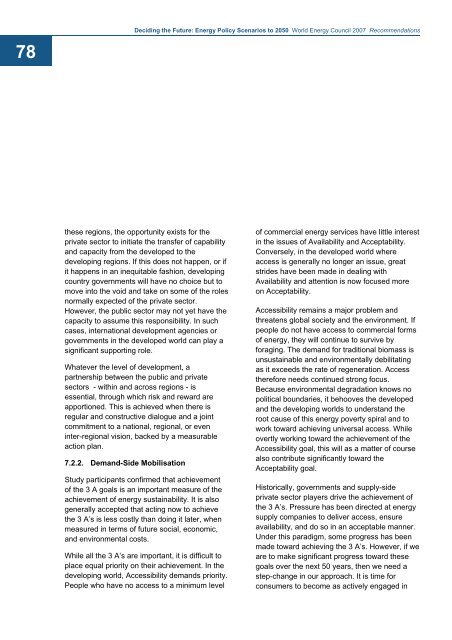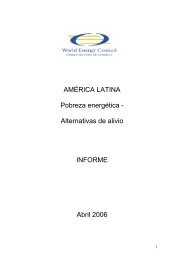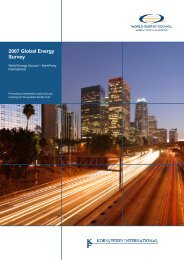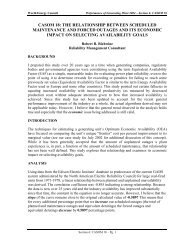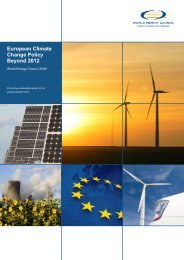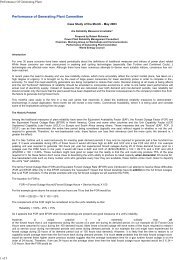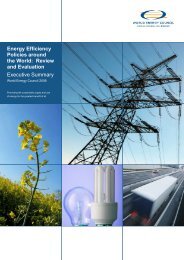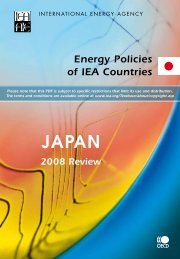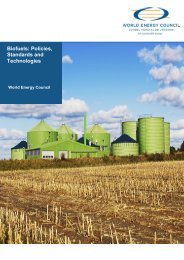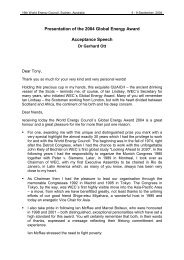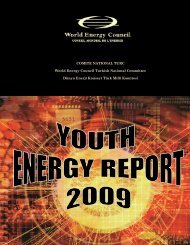Deciding the Future: Energy Policy Scenarios to 2050
Deciding the Future: Energy Policy Scenarios to 2050
Deciding the Future: Energy Policy Scenarios to 2050
You also want an ePaper? Increase the reach of your titles
YUMPU automatically turns print PDFs into web optimized ePapers that Google loves.
78<br />
<strong>Deciding</strong> <strong>the</strong> <strong>Future</strong>: <strong>Energy</strong> <strong>Policy</strong> <strong>Scenarios</strong> <strong>to</strong> <strong>2050</strong> World <strong>Energy</strong> Council 2007 Recommendations<br />
<strong>the</strong>se regions, <strong>the</strong> opportunity exists for <strong>the</strong><br />
private sec<strong>to</strong>r <strong>to</strong> initiate <strong>the</strong> transfer of capability<br />
and capacity from <strong>the</strong> developed <strong>to</strong> <strong>the</strong><br />
developing regions. If this does not happen, or if<br />
it happens in an inequitable fashion, developing<br />
country governments will have no choice but <strong>to</strong><br />
move in<strong>to</strong> <strong>the</strong> void and take on some of <strong>the</strong> roles<br />
normally expected of <strong>the</strong> private sec<strong>to</strong>r.<br />
However, <strong>the</strong> public sec<strong>to</strong>r may not yet have <strong>the</strong><br />
capacity <strong>to</strong> assume this responsibility. In such<br />
cases, international development agencies or<br />
governments in <strong>the</strong> developed world can play a<br />
significant supporting role.<br />
Whatever <strong>the</strong> level of development, a<br />
partnership between <strong>the</strong> public and private<br />
sec<strong>to</strong>rs - within and across regions - is<br />
essential, through which risk and reward are<br />
apportioned. This is achieved when <strong>the</strong>re is<br />
regular and constructive dialogue and a joint<br />
commitment <strong>to</strong> a national, regional, or even<br />
inter-regional vision, backed by a measurable<br />
action plan.<br />
7.2.2. Demand-Side Mobilisation<br />
Study participants confirmed that achievement<br />
of <strong>the</strong> 3 A goals is an important measure of <strong>the</strong><br />
achievement of energy sustainability. It is also<br />
generally accepted that acting now <strong>to</strong> achieve<br />
<strong>the</strong> 3 A’s is less costly than doing it later, when<br />
measured in terms of future social, economic,<br />
and environmental costs.<br />
While all <strong>the</strong> 3 A’s are important, it is difficult <strong>to</strong><br />
place equal priority on <strong>the</strong>ir achievement. In <strong>the</strong><br />
developing world, Accessibility demands priority.<br />
People who have no access <strong>to</strong> a minimum level<br />
of commercial energy services have little interest<br />
in <strong>the</strong> issues of Availability and Acceptability.<br />
Conversely, in <strong>the</strong> developed world where<br />
access is generally no longer an issue, great<br />
strides have been made in dealing with<br />
Availability and attention is now focused more<br />
on Acceptability.<br />
Accessibility remains a major problem and<br />
threatens global society and <strong>the</strong> environment. If<br />
people do not have access <strong>to</strong> commercial forms<br />
of energy, <strong>the</strong>y will continue <strong>to</strong> survive by<br />
foraging. The demand for traditional biomass is<br />
unsustainable and environmentally debilitating<br />
as it exceeds <strong>the</strong> rate of regeneration. Access<br />
<strong>the</strong>refore needs continued strong focus.<br />
Because environmental degradation knows no<br />
political boundaries, it behooves <strong>the</strong> developed<br />
and <strong>the</strong> developing worlds <strong>to</strong> understand <strong>the</strong><br />
root cause of this energy poverty spiral and <strong>to</strong><br />
work <strong>to</strong>ward achieving universal access. While<br />
overtly working <strong>to</strong>ward <strong>the</strong> achievement of <strong>the</strong><br />
Accessibility goal, this will as a matter of course<br />
also contribute significantly <strong>to</strong>ward <strong>the</strong><br />
Acceptability goal.<br />
His<strong>to</strong>rically, governments and supply-side<br />
private sec<strong>to</strong>r players drive <strong>the</strong> achievement of<br />
<strong>the</strong> 3 A’s. Pressure has been directed at energy<br />
supply companies <strong>to</strong> deliver access, ensure<br />
availability, and do so in an acceptable manner.<br />
Under this paradigm, some progress has been<br />
made <strong>to</strong>ward achieving <strong>the</strong> 3 A’s. However, if we<br />
are <strong>to</strong> make significant progress <strong>to</strong>ward <strong>the</strong>se<br />
goals over <strong>the</strong> next 50 years, <strong>the</strong>n we need a<br />
step-change in our approach. It is time for<br />
consumers <strong>to</strong> become as actively engaged in


